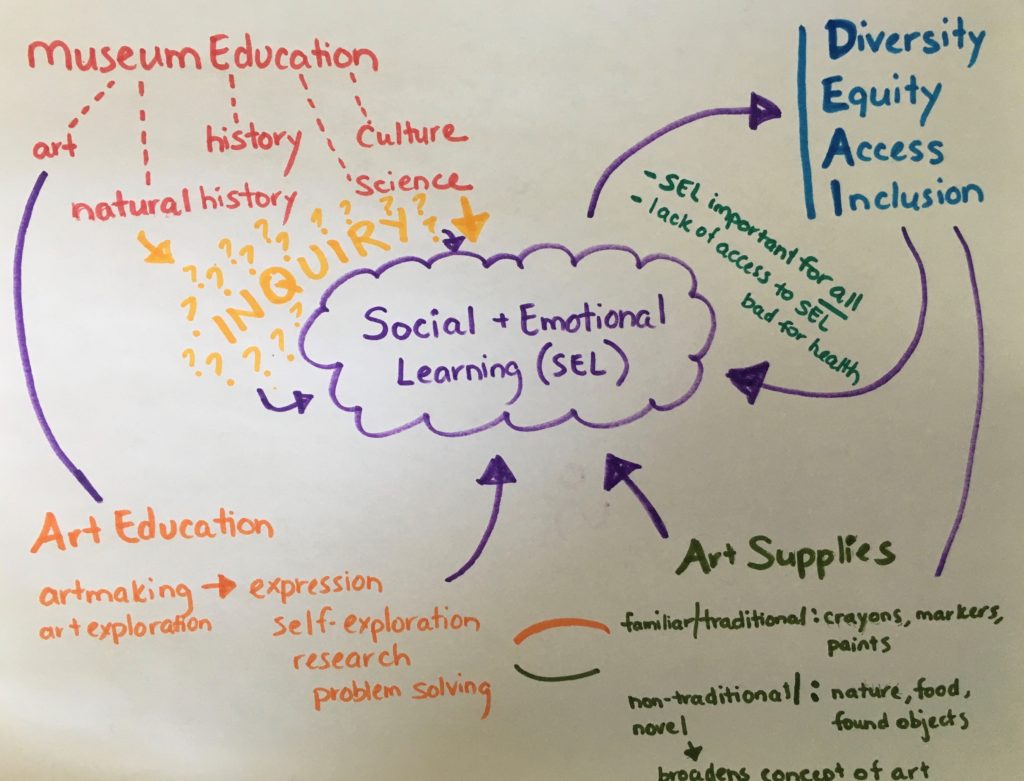This is an Eval Central archive copy, find the original at rka-learnwithus.com.
Shortly after posting my last blog on social and emotional learning being imperative and in museum educators’ wheelhouse, some conversations with clients, colleagues, and research participants further drove this point home for me. In my first post, I wrote about how important question-posing is for social and emotional learning and how museum educators are often masters of questioning. I realized this week there are other ways art museum educators can play a critical role in promoting social and emotional learning, all the while attending to museum’s audience-focused Diversity Equity Access and Inclusion (DEAI) efforts during this time.
Here are the three experiences that have led me to this conclusion:
1. Interviews with preschool teachers about art and art museums: I have been speaking with preschool teachers, many of whom work for state-funded public preschools, about the role of art and art museums in support of their curriculum. One of the trends across these interviews is how integrated art is into the preschool classroom. Art is often described as a means of expression, reflection, and meaning making. For instance, preschool teachers ask students to draw as a way to reflect on fieldtrips and other classroom learning (e.g., draw something you remember from the fieldtrip, or draw something you recall from a story we read this week). Other times, drawing prompts are more broad, such as draw your house or room, to stimulate conversation. Preschool educators may ask the children about what they drew as a means to support social and emotional learning specifically (e.g., child talks about being sad because grandmother who lives with them is ill, etc.).
2. Update from an art museum client on their work: In a project update phone call, one of our art museum clients shared how they have used the funding from the family programs they would have been hosting if the museum were open to donate art supplies to the community. The museum plans to disseminate art supplies to local students’ families when they pick up breakfast and lunches at their schools (free- and reduced-lunch program). This idea personally struck me as so resonant. At my child’s school, her art teacher has been posting art assignments each week. Conversations in the Google Classroom have raised the issue that some families do not have “traditional” art supplies at home (and maybe cannot afford them). To the art teacher’s credit, she always gives a found-object option to complete assignments, but it still seems that guardians have some anxiety around their child not having art aupplies. As noted in the example, access to art making is an important outlet for social and emotional learning among preschool students and others. Therefore, providing access to art supplies seems to be a really on-point undertaking and one that is likely mission-related for art museums. Furthermore, our client noted that this endeavor will allow them to connect to even broader audiences than they may have reached through their family programs. Which leads me to…
3. Visitor Studies Association webchat, Attending to DEAI during the time of COVID–19: I helped to support a DEAI webchat with Jill Stein, Dr. Cecilia Garibay, and VSA’s Understanding Communities focused interest group. The conversation emphasized not letting DEAI conversations fall to the wayside at this time. As Cecilia pointed out, there seems to be a false dichotomy set up where museum leadership feels they cannot tackle DEAI and the current pandemic. As the example above demonstrates, it is possible to do both even if it is through what may be perceived as a small gesture. Circling back to social and emotional learning, the American Physchological Assocation notes that socioeconomic status (SES) “is a consistent and reliable predictor of a vast array of outcomes across the life span, including physical and psychological health.” There is a high need for support of social and emotional learning, particularly for those challenged by socioeconomic inequalities—access to social and emotional learning support is indeed an equity issue. Children most in need of social and emotional learning support are those disconnected from sources of that support which they receive in school from counselours and in the art classroom. Donating art supplies may not typically have been consider a DEAI initiative before, but it is certainly linked to such issues.
Again, I think social and emotional learning is a place art museums in particular can fill a void. It may mean doing things differently, but that is exactly what we should be embracing at this time. It reminds me of when a museum educator shared during an American Alliance of Museums conference in 2015 that she felt the education team was better and more innovate when their museum building was closed for construction. All museums are now without a building, so let’s start thinking outside that box.
While I was writing this blog, a conversation was posted to Art Museum Teaching that is extremely relevant: Trauma-aware Art Museum Education: A Conversation

The post Social and Emotional Learning is Imperative and in Museum Educators’ Wheelhouse: Part 2 appeared first on RK&A.